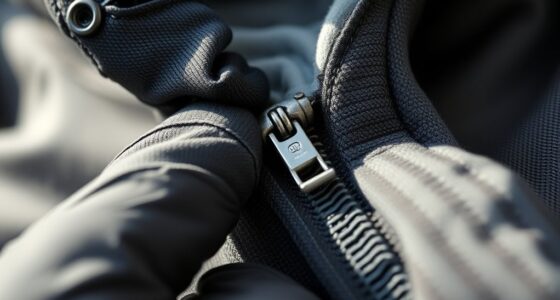To prevent wrinkles, the military roll works best for sturdy fabrics like denim or cotton, offering quick packing and space savings. If you’re packing delicate or wrinkle-prone clothes, the bundle method provides superior wrinkle control by wrapping garments around a core. Packing cubes can enhance both techniques by organizing and reducing movement. For a well-packed, wrinkle-free suitcase, understanding which method suits your clothes and trip can make all the difference—discover the details to optimize your packing.
Key Takeaways
- The bundle method minimizes wrinkles, making it ideal for delicate, wrinkle-prone fabrics like silk and linen.
- The military roll is quick, space-efficient, and best suited for sturdy, wrinkle-resistant fabrics such as denim and thick cotton.
- Using packing cubes enhances organization and wrinkle prevention with either method, especially for delicate items.
- The bundle method requires more time but offers superior wrinkle control; the roll method is faster but may cause more creases on delicate fabrics.
- Selection depends on fabric type, trip duration, and packing speed, with the bundle method prioritizing wrinkle-free results.

Packing efficiently can help you avoid the frustration of wrinkled clothes upon arrival. When it comes to keeping your garments smooth and presentable, understanding different packing techniques makes a big difference. Two popular methods—the military roll and the bundle method—each have their strengths, especially when considering fabric types and the use of packing cubes. Your choice depends on your clothing, trip duration, and packing style.
First, consider fabric types. Lightweight, wrinkle-prone fabrics like linen or silk can benefit from the bundle method because it minimizes creases during compression. The bundle method involves wrapping clothes around a central core, which reduces the chances of sharp folds that cause wrinkles. Conversely, sturdier fabrics such as denim or thick cotton often withstand rolling better without wrinkling. These fabrics can be packed using a military roll, where you tightly roll each item into a compact cylinder. The roll method is quick and keeps your clothes organized, especially when combined with packing cubes.
Packing cubes are game-changers for both techniques. They help compartmentalize your clothing, prevent shifting, and make it easier to access specific items without disturbing other garments. When you use packing cubes with the military roll, you benefit from an extra layer of organization and compression. You can dedicate separate cubes for different categories—shirts, pants, underwear—making unpacking a breeze and reducing the risk of wrinkles from unnecessary movement. For the bundle method, packing cubes serve as a wrapper around your bundled clothes, maintaining the shape and preventing loose fabric from unfolding. This wrapping can also help smooth out minor wrinkles and keep your clothes compact.
The military roll excels in saving space. It’s especially useful for t-shirts, activewear, and casual garments that don’t wrinkle easily. Plus, it’s fast: you simply fold the item in half, roll tightly from the bottom, and tuck the edges in. When combined with packing cubes, you create neat, space-efficient stacks that are easy to access and transport. The bundle method, on the other hand, takes more time but offers superior wrinkle prevention for delicate fabrics. It involves layering clothes flat, folding each layer carefully around a central core, and wrapping the entire bundle in a cloth or packing material. Using packing cubes to secure and compress your bundle can further reduce wrinkles and maximize space. Additionally, choosing wrinkle-resistant fabrics can enhance the effectiveness of your packing method and ensure your clothes arrive looking fresh.
Ultimately, your choice hinges on your clothing’s fabric types and how much time you want to invest. If you’re packing mostly sturdy fabrics and value speed, the military roll with packing cubes works well. If you’re dealing with delicate, easily wrinkled fabrics, the bundle method, enhanced with packing cubes, provides better wrinkle control. Both techniques, when combined with thoughtful packing tools, help you arrive at your destination with clothes that look fresh and unwrinkled.
Frequently Asked Questions
Which Packing Method Is Faster to Learn?
When considering which packing method is faster to learn, you’ll find that the learning curve plays a significant role. The military roll typically has a gentler learning curve, making skill acquisition quicker for beginners. With practice, you can master the military roll faster, saving you time and effort. The bundle method may take longer initially, but once learned, it can also be efficient. Overall, the military roll is usually easier and quicker to pick up.
How Do These Methods Work With Delicate Fabrics?
Think of delicate fabrics as fragile butterflies, needing gentle handling. With the military roll, you keep fabric care in mind by rolling tightly, reducing pressure that could cause damage. The bundle method, like wrapping a gift, offers folding precision, gently cradling delicate materials. Both methods work well, but you should choose based on your fabric’s softness and how carefully you want to maintain its pristine condition.
Are There Size Limitations for Each Method?
When considering size restrictions, both packing methods have their limits. The military roll minimizes space and offers good storage flexibility for smaller items, but large, bulky fabrics may not roll tightly. The bundle method handles larger pieces better, but it can reduce storage flexibility and may result in more wrinkles. Ultimately, your choice depends on the size of your clothing and your packing space, balancing size restrictions with how neat you want your items to stay.
Which Method Saves More Space?
Did you know that the bundle method typically offers 10-15% better space efficiency than rolling? When it comes to packing density, the bundle method compresses clothes more tightly, saving more space in your luggage. If maximizing space is your goal, the bundle method’s superior compression makes it the better choice. You’ll fit more in your bag and reduce overall bulk, making your travel more convenient.
Can These Techniques Be Used for Bulky or Heavy Items?
When packing bulky items or heavy gear, both the military roll and bundle method have limitations. The military roll compresses items tightly, but bulky gear might still be too rigid. The bundle method can help reduce wrinkles but may not save much space for heavy or oversized items. You should consider alternative packing techniques, like using compression bags or specialized containers, to better manage bulky or heavy gear during travel.
Conclusion
When you choose between the military roll and the bundle method, you’re sculpting your packing masterpiece. The military roll offers sleek, wrinkle-free precision, like a well-orchestrated symphony, while the bundle method provides gentle folds, reminiscent of a delicate origami. Whichever you pick, think of your clothes as dancers, ready to perform on your journey’s stage. With a little practice, you’ll master the art of packing, turning chaos into calm and wrinkles into smooth, silent harmony.









